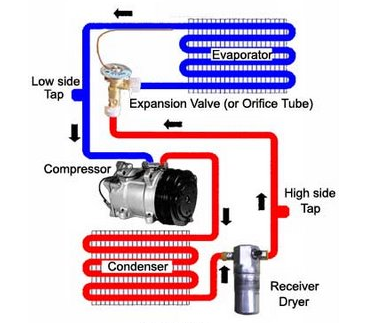AC System Basics
You need to know what you’re getting into when working on your vehicle’s AC system. Several laws govern the use of refrigerant and how it is handled in automotive systems. Be sure to check your local laws to confirm that you’re even allowed to service your AC system.
To be honest, I feel like I’m handing you a loaded gun with this information. I can’t tell you how many times I’ve seen even seasoned techs handle AC improperly. I take it a bit more seriously, and I suggest you do as well. After all, I had to pass a certification test before I was even able to service AC systems. Anyone who isn’t certified and is caught in a shop working on AC is subject to some pretty steep fines. Keep that in mind and take it seriously.
It doesn’t matter who makes it; all AC systems work on some rather simplistic principles. The main principle is the pressure-temperature relationship. This is a term used in physics to describe how a material reacts at different temperatures and pressures, and also what happens to it when it changes states. By changing states, I’m referring to when refrigerant changes from a liquid to a gas within the AC system. In the case of your automotive AC system, HFC R-134a is the most widely used refrigerant at this time. Before the 1994 – 1995 model years, CFC R-12 was used in systems; starting in 2013 – 2014, they will be using HFO-1234yf. At least they plan to use HFO1234yf; I’ve heard of some controversy surrounding that refrigerant that might give it a short life span. Honestly, unless you’re in the collision industry, I think it will be some time before you need to service one of these systems anyway. We’ll cross that bridge when we come to it.
Regardless of the type of refrigerant used, they all use the same basic principles. You take a high-pressure liquid, run it through a small opening, and turn it into a low-pressure gas. This is what causes the cooling effect in your AC system. This change of state and pressure is the pressure-temperature relationship at work. As the refrigerant goes from a high-pressure liquid to a low-pressure gas, it gives up a lot of heat. A common misconception is that the AC system cools. This is not necessarily true. What really happens is the AC system takes the warm air from the passenger compartment and moves it outside the passenger compartment in front of the radiator. It’s more of a heat exchanger than anything else. Your AC system moves heat; think of it that way. When the evaporator inside your dash gets cool, it absorbs heat. It then takes this heat and moves it out to the condenser in front of the radiator where the heat is dissipated into the atmosphere.
The refrigerant is moved through the system via the AC compressor. The compressor draws in low-pressure gas from the exit pipe of the evaporator, and then outputs it at a higher pressure and sends it towards the condenser. The compressor should never have liquid refrigerant in it. It could suffer a lot of damage if it did. Your compressor is meant to compress gas, not liquid.
While the refrigerant is in the condenser, it gains in temperature and pressure and turns back into a liquid. Once it leaves the condenser as a high-pressure liquid, it then moves it to the orifice just before the evaporator where it is turned back into a gas, the pressure is greatly reduced, heat is released, and the cycle starts again.
The AC system is split into two parts: the high-pressure side and the low-pressure side. The high-pressure side is from the output side of the compressor, through the condenser, to the back side of the variable opening before the evaporator. There are many configurations and terms for this opening. It’s sometimes called an expansion valve and sometimes an orifice tube; either way, they all do the same thing, which is to help change the high-pressure liquid refrigerant into a low-pressure gas. The low-pressure side is from that orifice near the evaporator (low-pressure side) all the way to the intake of the compressor.
In addition to the compressor, evaporator, and condenser, a couple of other components are usually found on the AC system. One of these components is a variable opening to the evaporator. There are many different configurations and names for this, but the idea is to regulate the size of the opening going into the evaporator for maximum efficiency.
Besides a variable opening, you’ll also see either a receiver dryer or an accumulator, depending on where it’s located in the system. Receiver dryers are normally located near the outlet of the condenser on the high side of the system. These are placed in the system to help remove moisture. Any moisture in the AC system will affect its performance, so you should take great pains to keep it out when working on your AC system. Here is a video describing in more detail how the AC system operates.
Video Title: AC System Basics – Solving Automotive HVAC Problems – EricTheCarGuy Video Description: In this Article we talk about AC System Basics. Thumbnail: http://www.ericthecarguy.com/images/faq_buttons/Large_FAQ_Images/HVAC-icon-1200.png
 Our Address
Our Address



